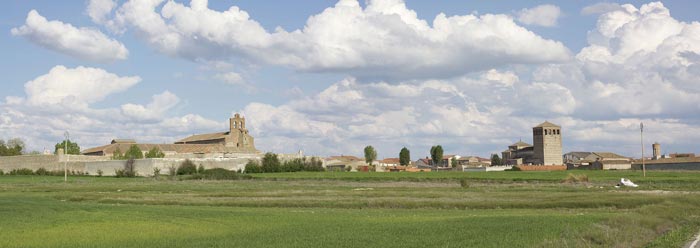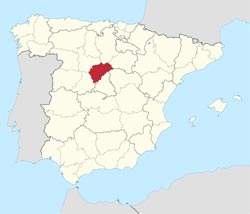Segovia in Segovia

The province of Segovia is situated in the region of Castilla y León to the northwest of the community of Madrid, not far off the centre of Spain. It is the smallest of Castilla y León’s nine provinces with its 6,920.65 km2.
 Apart from Madrid, the province borders on Ávila, Valladolid, Burgos and Soria, all fellow Castilla y León provinces, and on Guadalajara province in Castilla-La Mancha. The highest point in the province is the Peñalara peak in Sierra de Guadarrama.
Apart from Madrid, the province borders on Ávila, Valladolid, Burgos and Soria, all fellow Castilla y León provinces, and on Guadalajara province in Castilla-La Mancha. The highest point in the province is the Peñalara peak in Sierra de Guadarrama.
The weather in Segovia is quite cool and wet. The summers are short, hot and dry with mainly clear skies, and the winters are very cold and often overcast. Over a year the temperature usually varies between -1ºC and +29ºC, and it rarely goes below -5 or above +33. The so-called ‘wettest season’ runs from 29th September to 15th June, and the average annual rainfall is 460 mm. Segovia is home to 154,095 souls, 52,188 of whom belong in the capital of the same name.
When they hear the name Segovia, most people envisage the impressive Roman aqueduct that crosses the old city and which is definitely its trademark, centre of attention and a popular meeting place. But was it really the Romans that built it?
Legend has it that it was, in fact, the work of the devil himself! The story goes that a young maid whose duty it was to go down the hill from her house and up the hill on the other side every day to collect water from the spring and bring it back along the steep streets of the city, got so tired of this hard work that one day she swore that she’d give her soul to the devil if he would construct an aqueduct that would relieve her of this arduous chore. Of course, Lucifer was not going to miss an opportunity like that so he agreed, and the deal was that if he could finish the aqueduct before the first rooster’s crow in the morning, the maiden would give him her soul. Of course, as soon as she got home, she regretted what she had done, and she spent all night praying for help and forgiveness and also to avoid falling into a trance and lose her soul, while legions of little devils worked at the foot of the hill, adding stone after stone to construct a mass of granite. The maid’s soul would be theirs if they finished in time! But the young girls’ prayers prevailed, and just when there was one stone missing, the first cock crowed, and the devil lost his opportunity and her soul. It is said that the holes in the masonry are the marks of Lucifer’s hooves when he fled the from the aqueduct in a rage.
But although the old city and the aqueduct are world famous and a UNESCO World Heritage Site, there is far more to Segovia than that. Long before humans walked the earth, some 60,000 years ago, the site where Segovia now stands was inhabited by Neanderthal man. Tens of thousands of years later, the area now covered by Segovia’s suburbs was the site of first Copper Age and later Bronze Age settlements. During the Roman occupation of the Iberian Peninsula, Segovia was just a small Roman town on an isolated hill at the junction of two rivers on the main road from Emerita (Merida) to Caesaraugusta (Zaragossa). Despite its small size, the town was supplied with water by an impressive aqueduct which was built sometime in the first or second century.
During the Visigoth rule the city was the episcopal seat of the Catholic church, but after the Muslim invasion Segovia was abandoned and not to be re-populated until 1088 after the reconquest of Toledo, when Christians were ‘volunteered’ to move there from northern Spain. Segovia boasts a very impressive castle, which sits at the top of the city overlooking its lower parts and the surrounding countryside. Construction was started in the early 12th century and the original castle was finished in 1122. It has been claimed that Walt Disney’s cartoon castles were modelled on the Alcázar de Segovia.
There are many other precious places to visit in Segovia, including its magnificent cathedral, la Santa Iglesia Catedral de Nuestra Señora de la Asunción y de San Frutos de Segovia. Quite a mouthful! It is also known as the Lady of Cathedrals due to its dimensions and elegance. But even visitors that are not looking to spend hours traversing the city from monument to monument will find an array of charming, narrow streets with flower laden balconies; spacious squares and plazas strewn with bars and eateries, and all over the city, no end of beautiful sights and views.


